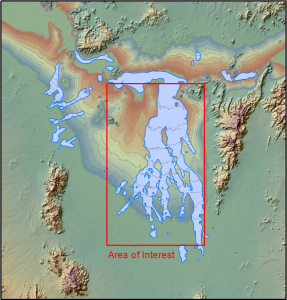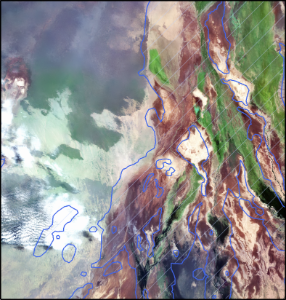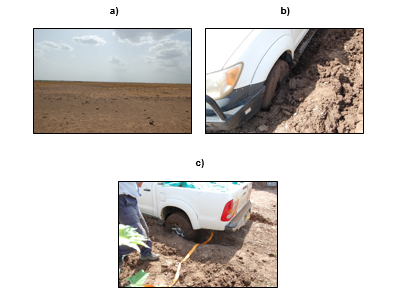Data processing was completed using ESRI ArcMap software. SRTM-90 elevation and MODIS derived flood extent data (as identified by the Dartmouth Flood Observatory) were collected. Figure 1 shows elevation ranges scaled to emphasise flat areas, with extracted 5 m contours overlain. The cumulative flood extent limit is also shown as derived for the years 2002, 2005, 2006, 2011, 2012, and 2013. Significant variation in elevation is present even in relatively flat areas. Combining both elevation and historic flood data, it was possible to identify low lying, low gradient areas that were potential flood risk zones. The identified flood risk areas were then compared to SPOT-6 satellite image data, which showed a correlation between the DTM and the flood extents and a visual change in ground characteristics within these extents, as illustrated in Figure 2. These flood prone areas were cross referenced against the planned seismic survey to identify seismic lines that could potentially present difficulties associated with flooding or wet ground when acquisition was carried out. As the flood susceptible area represented a considerable part of the acquisition target area, it was difficult to propose a suitable operation contingency plan avoiding the questionable areas during the worst months. Ground conditions and soil composition were left as unknowns in the planning process to be addressed once operations were initiated. The flood prone areas were identified successfully from analysis of existing satellite EO datasets. The EO datasets are useful at the start of the planning process to quantify potential issues caused by flooding and wet ground, but further desirable information would include soil composition and stability to establish whether the identified areas are capable of supporting heavy machinery and vehicles without causing too much damage or delaying operations, and whether this changes depending on the season. The seismic survey was concluded with no major time extensions and with limited standby time caused by flooding, partly due to lower than average rainfall for the survey acquisition time window. Some logistical problems were associated with wet ground but these could not have been avoided; however a better understanding of them beforehand would have been beneficial – see Figure 3. Figure 1: SRTM-90 variation in flood prone areas
Showing 5 m contours superimposed on historic flood limits:2002, 2005, 2006, 2011, 2012, 2013. |
Figure 2: SPOT-6 (1.5 m) colour image and flood limits
Image variations correspond to flood prone areas – comparison to historic flood extents. |
|
Figure 3: Typical landscape and flood associated problems
|